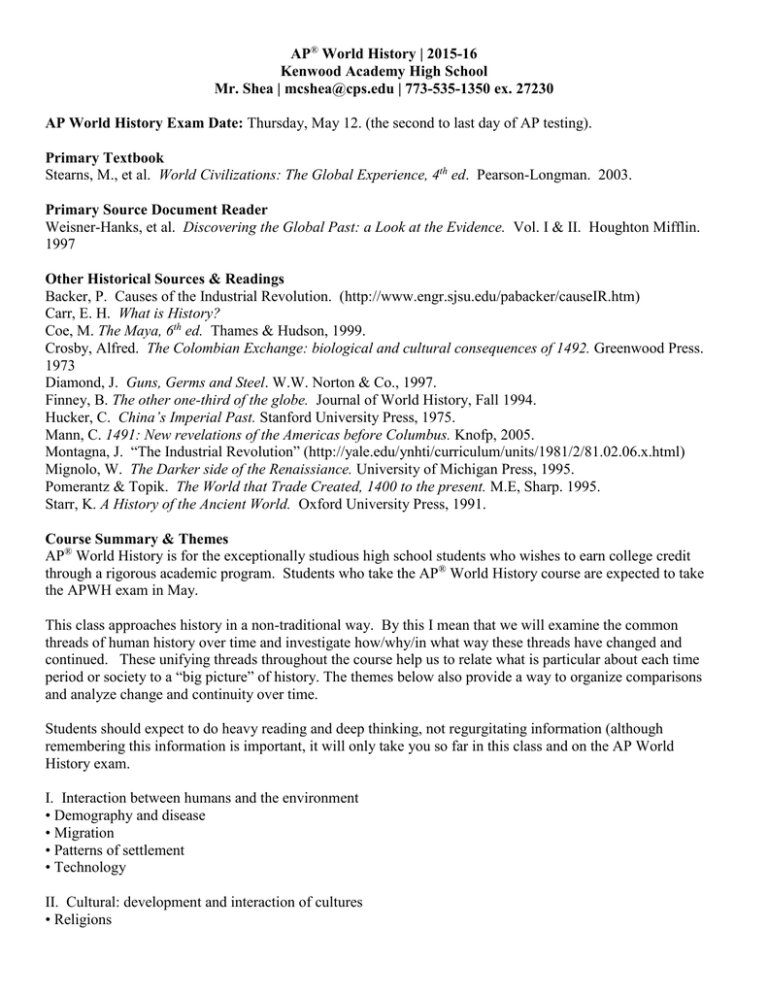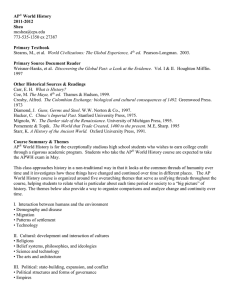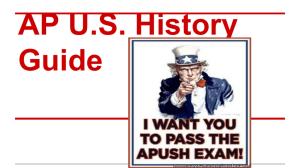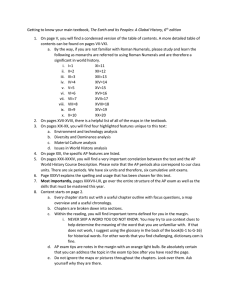
AP® World History | 2015-16
Kenwood Academy High School
Mr. Shea | mcshea@cps.edu | 773-535-1350 ex. 27230
AP World History Exam Date: Thursday, May 12. (the second to last day of AP testing).
Primary Textbook
Stearns, M., et al. World Civilizations: The Global Experience, 4th ed. Pearson-Longman. 2003.
Primary Source Document Reader
Weisner-Hanks, et al. Discovering the Global Past: a Look at the Evidence. Vol. I & II. Houghton Mifflin.
1997
Other Historical Sources & Readings
Backer, P. Causes of the Industrial Revolution. (http://www.engr.sjsu.edu/pabacker/causeIR.htm)
Carr, E. H. What is History?
Coe, M. The Maya, 6th ed. Thames & Hudson, 1999.
Crosby, Alfred. The Colombian Exchange: biological and cultural consequences of 1492. Greenwood Press.
1973
Diamond, J. Guns, Germs and Steel. W.W. Norton & Co., 1997.
Finney, B. The other one-third of the globe. Journal of World History, Fall 1994.
Hucker, C. China’s Imperial Past. Stanford University Press, 1975.
Mann, C. 1491: New revelations of the Americas before Columbus. Knofp, 2005.
Montagna, J. “The Industrial Revolution” (http://yale.edu/ynhti/curriculum/units/1981/2/81.02.06.x.html)
Mignolo, W. The Darker side of the Renaissiance. University of Michigan Press, 1995.
Pomerantz & Topik. The World that Trade Created, 1400 to the present. M.E, Sharp. 1995.
Starr, K. A History of the Ancient World. Oxford University Press, 1991.
Course Summary & Themes
AP® World History is for the exceptionally studious high school students who wishes to earn college credit
through a rigorous academic program. Students who take the AP® World History course are expected to take
the APWH exam in May.
This class approaches history in a non-traditional way. By this I mean that we will examine the common
threads of human history over time and investigate how/why/in what way these threads have changed and
continued. These unifying threads throughout the course help us to relate what is particular about each time
period or society to a “big picture” of history. The themes below also provide a way to organize comparisons
and analyze change and continuity over time.
Students should expect to do heavy reading and deep thinking, not regurgitating information (although
remembering this information is important, it will only take you so far in this class and on the AP World
History exam.
I. Interaction between humans and the environment
• Demography and disease
• Migration
• Patterns of settlement
• Technology
II. Cultural: development and interaction of cultures
• Religions
• Belief systems, philosophies, and ideologies
• Science and technology
• The arts and architecture
III. Political: state-building, expansion, and conflict
• Political structures and forms of governance
• Empires
• Nations and nationalism
• Revolts and revolutions
• Regional, trans-regional, and global structures and organizations
IV. Economic: creation, expansion, and interaction of economic systems
• Agricultural and pastoral production
• Trade and commerce
• Labor systems
• Industrialization
• Capitalism and socialism
V. Social: development and transformation of social structures
• Gender roles and relations
• Family and kinship
• Racial and ethnic constructions
• Social and economic classes
APWH Unit Overview & Skill emphasis
Students will be able to:
Construct and evaluate arguments, and plausibly use historical evidence
Analyze and use primary source documents and evidence
Evaluate change and continuity over time with an emphasis on process and causation
Understand diverse interpretations of events through context and point of view
Evaluate and understand patterns and interactions from local to global levels
Analyze comparisons within and among societies
Become aware of similarities and differences among peoples and understand cultural diversity
Answer correctly AP-style multiple choice questions
Effectively compose the three types of APWH essays: the document-based essay (DBQ), the changeover-time essay (CCoT), and the comparative essay (CC)
Period 1, To 600 BCE: Technological and Environmental Transformations
Key Concepts:
• Big Geography and the Peopling of the Earth
• Neolithic Revolution and Early Agricultural Societies
• Development and Interactions of Early Agricultural, Pastoral, and Urban Societies
Topics for Overview include:
• Prehistoric Societies
• From Foraging to Agricultural and Pastoral Societies
• Early Civilizations: Middle East, South Asia, East Asia, the Americas, Africa, and Oceania
Skill Focus:
Lecture and Text note taking and time management;
Read & Analyze: Understand the diversity & variety of culture and subsistence in Polynesian society,
read Diamond, Guns Germs and Steel (p. 53-66).
Study skills & techniques
AP World Map
Thesis writing & essay construction (diagramming and comparison essay): Explain the means by which
human society transitioned from nomadic or semi nomadic society to settled, complex civilizations. Use
specific examples from 2 of the 4 river valley regions.
Visual literacy: maps of human migrations, hominid fossil record, AP World Map
Period 2, 600 BCE-600 CE: Organization and Reorganization of Human Societies [22 days, 15%]
Key Concepts:
• Development and Codification of Religious and Cultural Traditions
• Development of States and Empires
• Emergence of Transregional Networks of Communication and Exchange
Topics for Overview include:
• Classical Civilizations
• Major Belief Systems: World Religion & world view
• Early Trading Networks & Migrations: Bantu (Africa) & Maori Migration (Polynesia &
Australia/NewZealand)
Skill Focus:
Thesis writing & essay construction (diagramming)
Essay: (CC) Students will compose a 2-3 page essay that compares two of the 5 world religions in detail
specific to the theology of each religion and to the world views derived from that theology. Choice:
Hinduism & Buddhism OR the Judaism & Islam. (2 drafts)
Mini Document Analysis: theme/main point, point of view, author/bias
Chronological Reasoning Charts: a) distinguish between coincidence, causation & correlation, b)
continuity and Change over time
Full Practice APWH Exam (optional)
Debate: Isolation vs Integration: benefits of a “global” world vs. an isolated state
Visual literacy: maps of Fertile Crescent, Huang He RV, Subcontinent of Asia, Roman Empire over
time, religious artifact and symbol
Period 3, 600-1450: Regional and Transregional Interactions [29 days, 20%]
Key Concepts:
• Expansion and Intensification of Communication and Exchange Networks
• Continuity and Innovation of State Forms and Their Interactions
• Increased Economic Productive Capacity and Its Consequences
Topics for Overview include:
• Byzantine Empire, Dar-al Islam, & Germanic Europe
• Crusades
• Sui, Tang, Song, and Ming empires
• The Americas & Oceana/Polynesia
• The Turkish Empires
• Italian city-states
• Kingdoms & Empires in Africa: cultural commonality & genetic diversity
• The Mongol Khanates
• Trading Networks in the Post-Classical World
Skill Focus:
Essays: (CC) Islamic Caliphate & Byzantine Europe, Feudal Europe & Japan, Meso-american &
Polynesian political structure; (CCoT) North and West Africa and the Middle East.
Mini Document Analysis: Analyze the Legal Code from the Byzantine Empire (document 3, p. 118) and
the Passage from the Koran (document 1, p. 118) and identify the following for both sources a) the type
of source and what the role that source plays in the culture of the intended audience, b) the concise
message the sources is transferring to the reader, c) comparing the two, describe the reception a modern
audience may have of its message and support your answer with reason.
Full DBQ Chart: Stearns p.118-119—grouping/chunking documents
Practice APWH Exam (optional)
Perspective: Recent archaeological and anthropological research from Mann’s 1491 will be used to ask
students to reevaluate aspects of pre-Columbian societies in the Americas, such as their size,
sophistication, and trade networks
Visual literacy: Visual DBQ—Create a powerpoint presentation where you demonstrate continuity and
change in Chinese civilization (in period 3) using visual documents. Use the “notes box” in powerpoint
for citation and a brief explanation of the continuity or change being identified.
Period 4, 1450-1750: Global Interactions [29 days, 20%]
Key Concepts:
• Globalizing Networks of Communication and Exchange
• New Forms of Social Organization and Modes of Production
• State Consolidation and Imperial Expansion:
Topics for Overview include:
• The Trading Networks of the Indian Ocean
Prisoner Colonies: Australia & America
• Effects of the Continued Spread of Belief Systems
• Ming and Qing Rule in China
• Japanese Shogunates
Skill Focus & Activities:
Essays: (CC) Reconquest & Conquest (Spain & the Americas), the world economy and the African slave
trade, Catholic Church & Protestantism, Columbian exchange & cultural diffusion, Feudalism in Europe
& Japan; (CCoT) the role of the state 1095-1750 (European monarchs, Japanese Shoguns)
Read & Analyze: Finney, Ben. “The other 1/3 of the Globe” Explain why this region is considered
“outside the network” and what effect this designation may have had on the development of the region.
Document Based Question (DBQ): students analyze the readiness of each region to participate and
in and the effects of the global trade network including charts containing population growth rates
(doc 14), urbanization in China & Western Europe (doc. 17), per capita GDP in each region (doc.
15), population and GDP growth 1500-1700 (doc. 16), and slave exports from Africa by
destination (doc. 18) and others.
Mini Document Analysis: theme/main point, point of view, author/bias, & missing voice!
Debate: concept of the “human”, civilization and the slave trade
Visual literacy: students will infer conclusions about the growing international trade network by
comparing maps 16.1 & 16.2 (p, 362 & 364); students will infer conclusions about the growing
international trade network by comparing maps 16.1 & 16.2 (p, 362 & 364).
Period 5, 1750-1900: Industrialization and Global Integration [29 days, 20%]
Key Concepts:
• Industrialization and Global Capitalism: Colonialism & Neo-colonialism in Africa
• Imperialism and Nation-State Formation: Ottoman Empire & Balkan States
• Nationalism, Revolution and Reform: Mexico, Russia & China
• Global Migration: European & African
Topics for Overview include:
• The Age of Revolutions:
English Revolutions, Scientific Revolution & Enlightenment, American Revolution, French
Revolution and its fallout in Europe, Haitian & Latin American Revolutions
• Global Transformations:
Demographic Changes, the End of the Atlantic Slave Trade, Industrial Revolution and Its Impact,
Rise of Nationalism, Imperialism and its Impact on the World
Skill Focus:
Mini Document Analysis: DBQ: Stearns, p. 532-533
Essay: (CC) compare various political statements/ethos, decline of empires; (CCoT) capital and labor
1750-1900
Debate: Role of Women in Revolutions (Arab Spring & Enlightenment); Is the industrial revolution a
real revolution? (read the articles “The Industrial Revolution” by Montagna and “The Cause of the
industrial revolution” by Backer) identify analyze their thesis, identify key supporting details and
compare the validity of their arguments surrounding the industrial revolution.
Visual literacy: the universe, economic systems, industrial society
Period 6, 1900-present: Accelerating Global Change and Realignments [29 days, 20%]
Key Concepts:
• Science and the Environment
• Global Conflicts and Their Consequences
• New Conceptualizations of Global Economy and Culture
Topics for Overview include:
• Crisis and Conflict in the Early 20th Century:
Anti-Imperial Movements, World War I, Russian, Chinese and Mexican Revolutions, Depression,
Rise of Militaristic and Fascist Societies, World War II
• Internationalization:
Decolonization, the Cold War World, International Organizations, the Post-Cold War World,
Globalization
Skill Focus:
DBQ: Stearns, p. 678-679
Essay: (CC) compare independence movements in Europe, Asia and Latin America, compare economic
plans in Asia and Latin America, compare strengths & weaknesses of Fordism and Marxism, (CCoT)
Latin America 19th and 20th century, Capitalism from 1492-1989
Periodization Assignment: In past versions of the AP World course, period 6 began in the year 1910, it
was recently changed to begin in the year 1900—Make a claim explaining why this change has occurred,
explain if it is an appropriate or inappropriate change. Be sure to use evidence from the textbook or
class lecture to support your reason.
Practice APWH Exam (optional)
Visual literacy: Anlyze the Women at Work chart (p. 795) and write three claims that describe the
change in working women between 1946 and 1982. Examine national “branding” from a marketing
perspective & the role of culture and race in 21st century politics.
AP World History Grade Weight Distribution:
Formative Assessments: [35%]
Essays: 25%
Quizzes: 10%
Summative Assessments: [35%]
Quarter & Semester Exam: 20%
Unit Assessments: 15%
Participation: [30%]
*Successful Class Participation is defined by the following tasks & responsibilities:
1. Homework: maintaining course notebook with reading notes and class notes.
2. Discussions: contributing to class discussions and/or attentively listening to others ask and answer
questions
3. Class Preparation: attending class with all required material (text, notebook, notes, pen, other materials
required for a project)
4. Punctuality & Attendance: all students must be on time to class every school day, failure to do so will
harm the students grade and subject them to discipline per the student handbook.
****Extra credit is NOT offered in AP World History.****
Homework/Assignment Policy:
All assignments are due upon the date determined by the instructor, or per an arrangement made with the
instructor prior to the due date.
Reading assignments are to be completed upon the assigned date (see reading schedule)
Late Work: Any assignment submitted after the assignment has been reviewed in class will not be
graded and result in a zero. Should the absence be “excused” the student may submit the assignment the
day following their return to class.
Late work without “excuse” will be deducted 20% each day it is late for a maximum of 3 class days.
After three class days, the assignment will not be graded.
Class Tips:
There are several key things one must do in order to be successful in this class. Here they are:
Manage your time (prioritize your tasks and work from highest priority to lowest. Utilize all class time
provided to complete an assignment or reading.)
Do all the reading.
Answer the prompt—not what you wish the prompt to read.
Know the facts; emphasize relationships and themes
Use all of your resources:
o Me! (I have hours after school every week. I expect to see everyone at least once per Quarter!)
o Online help (there are tons of AP material online)
o Practice tests (Two will be done during the year, anything more is up to you.
o Do all of your assignments (failure to do so harms your grade. Exams and essays are difficult
enough, so why skip an easier assignment where you can do well?)
Chapter/Unit Tests
AP tests are not easy and do be successful you must prepare, and also to be prepared to change how you prepare.
What has worked in other AP classes, or other history classes may not have prepared you to synthesize all the
history of the world as tested by AP. Begin to mentally chew on this now and be prepared to adapt new
strategies and practice new skills.
How do I prepare? What must I do?
Here are some tips (not in order of importance):
1. Perfect practice makes perfect; perfection does not exist.
You will make mistakes, and you will be frustrated. Learn from your mistakes and do not allow
yourself to become discouraged; you can do everything this class asks if you decide to.
Also, I am here to help you achieve your goals for this class.
2. Block out your time
You are busy—just like everyone else in the universe—do not expect to have time treat you any
differently than anyone else. If you have a practice/club meeting after school until 6, and a several
assignments due the following day—stagger your work: do not wait until the last minute.
3. Manage your test time (pacing)
To do well, you must read accurately and quickly so you have time to think. Tests assess your ability to
read, think and respond. This is difficult and very stressful—but you will get better with proper practice.
You have reading to do every day and the AP test is in May—so you have tons of reading, many chapter
tests and 2 practice AP tests to assess your ability.
4. Answer the prompt
You must answer the question or writing prompt in front of you to receive credit. This sounds simple,
but people mess this up all the time. Especially clever students who think they can answer a different
questions correctly and get credit…this will not fly in AP. Occasionally you will not understand a
question. Pay attention to “dissecting the question” lessons in class. The AP test is constructed by some
very bright people and the questions are very specific—as a result, deviating from that question will lead
you in the wrong direction. “Wrong” answers are purposely created to distinguish between those
students who know and those that guess. (Yes, they created that wrong answer to “correctly” answer a
misreading of the question—so that answer is, therefore, wrong.) This is not sneaky. It is assessing
your critical reading ability and you content knowledge.
And, to be clear, it is kinda sneaky.
5. All tests are cumulative—including the AP test on Thursday, May 14.
Consistently review old material on your own throughout the year. Keep all your notes and study
material
6. Organize your notes
You must take class notes (format is optional) so be sure they are organized: date each page, clearly
label the topic, highlight or make note of important relationships/theme and the details that accompany
that relationship/theme
7. Use flash cards for the simple facts: who, what, when, where?
See the APWH page for a link to the textbook’s online flashcards
8. Read, read, read!
Do all the reading! It’s like university!
Do all the reading. The APWH exam emphasizes relationships and themes of history and the facts and
important details that accompany them. The textbook and supplemental readings will describe and
explain those relationships—so if you don’t do the reading, you won’t understand the relationships or
how what facts/details are associated with them.
No, this class does not assign more reading than a typical college level history class. In fact, you’d be
expected to read the same quantity of pages in half the time (most colleges use a semester schedule).
This ties into managing your time. Which explains why you may receive college credit for successfully
learning the material and navigating APWH exam in May!
9. Find a good place to read, study, review and do your work.
Find it now. Actually, find it like, yesterday. Make it a habit to go there every day and it will be easy to
do so later on.
10. Relax.
If you manage your time, stay on top of your work then you will be able to relax—and a relaxed mind
works better.
Writing Mechanics
Each essay assignment will address the items from each column below in relation to the specific AP essay type
(comparison, continuity and change over time, and document based question). Central to each essay type is
thesis construction, and thesis construction is tied to each of the items within Column II. The lessons around
DBQ’s will emphasize Column III, whereas the CCoT and CC essays will emphasize column II. Column I and
IV will be specifically integrated into each assignment.
Column I
(Length)
1. Sentence
2. Paragraph
3. Multiparagraph
Column II
(Purpose/Style)
1. Identify/Describe/Summarize
2. Explain the sequence
3. Analyze and Explain cause and
effect
4. Compare/Contrast
5. Evaluate and Explain the
significance
Column III
(Using sources)
1. Paraphrase
2. Quote
3. Plagiarize
4. Citations
Column IV
(Common Writing Errors)
1. subject-verb agreement
2. tense errors
3. pronoun errors
4. run-on/fragment errors
5. commas
6. other punctuation
7. homonym and other
common word errors
Standards:
This class will adhere to the Illinois learning standards pertaining to high school, the ACT college readiness
standards as well as Common Core State Standards.






